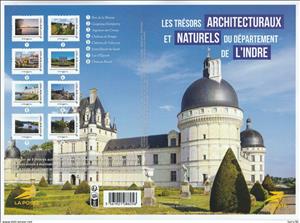Souvenir Sheet: Architectural and Natural Treasures of Indre (France 2025)
Architectural and Natural Treasures of Indre (France 2025)
01 June (France ) within release Collector : Architectural and Natural Treasures of Indre goes into circulation Souvenir Sheet Architectural and Natural Treasures of Indre face value 8*Lettre No Face Value
| Souvenir Sheet Architectural and Natural Treasures of Indre in catalogues | |
|---|---|
| Colnect codes: | Col: FR-COL 2025-20 |
Souvenir Sheet is square format.
Also in the issue Collector : Architectural and Natural Treasures of Indre:
- Souvenir Sheet - Architectural and Natural Treasures of Indre face value 8*Lettre;
- Stamp - Argenton-sur-Creuse face value Lettre;
- Stamp - Bourges Castle face value Lettre;
- Stamp - Brenne Park face value Lettre;
- Stamp - Eguzon Lake face value Lettre;
- Stamp - Gargilese Dampierre face value Lettre;
- Stamp - Raoul Castle face value Lettre;
- Stamp - Saint-Benoit-du-Sault face value Lettre;
- Stamp - Valencay Castle face value Lettre;
Souvenir Sheet Architectural and Natural Treasures of Indre it reflects the thematic directions:
Architecture (Latin architectura, from the Greek ἀρχιτέκτων arkhitekton "architect", from ἀρχι- "chief" and τέκτων "builder") is both the process and the product of planning, designing, and constructing buildings and other physical structures. Architectural works, in the material form of buildings, are often perceived as cultural symbols and as works of art. Historical civilizations are often identified with their surviving architectural achievements.
A castle (from Latin: castellum) is a type of fortified structure built in Europe and the Middle East during the Middle Ages by European nobility. Scholars debate the scope of the word castle, but usually consider it to be the private fortified residence of a lord or noble. This is distinct from a palace, which is not fortified; from a fortress, which was not always a residence for nobility; and from a fortified settlement, which was a public defence – though there are many similarities among these types of construction. Usage of the term has varied over time and has been applied to structures as diverse as hill forts and country houses. Over the approximately 900 years that castles were built, they took on a great many forms with many different features, although some, such as curtain walls and arrowslits, were commonplace.
A church building, often simply called a church, is a building used for Christian religious activities, particularly worship services. The term in its architectural sense is most often used by Christians to refer to their religious buildings, but it is sometimes used (by analogy) for buildings of other religions. In traditional Christian architecture, the church is often arranged in the shape of a Christian cross. When viewed from plan view the longest part of a cross is represented by the aisle and the junction of the cross is located at the altar area. Towers or domes are often added with the intention of directing the eye of the viewer towards the heavens and inspiring church visitors. Modern church buildings have a variety of architectural styles and layouts; many buildings that were designed for other purposes have now been converted for church use; and, similarly, many original church buildings have been put to other uses. The earliest identified Christian church was a house church founded between 233 and 256. During the 11th through 14th centuries, a wave of building of cathedrals and smaller parish churches occurred across Western Europe. A cathedral is a church, usually Roman Catholic, Anglican, Oriental Orthodox or Eastern Orthodox, housing the seat of a bishop.
A lake is a naturally occurring, relatively large and fixed body of water on the Earth's surface. It is localized in a basin or interconnected basins surrounded by dry land. Lakes lie completely on land and are separate from the ocean, although they may be connected with the ocean by rivers, such as Lake Ontario. Most lakes are freshwater and account for almost all the world's surface freshwater, but some are salt lakes with salinities even higher than that of seawater. Lakes vary significantly in surface area and volume.




